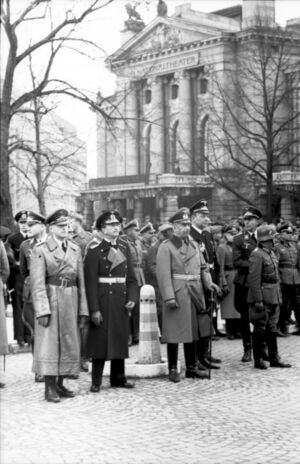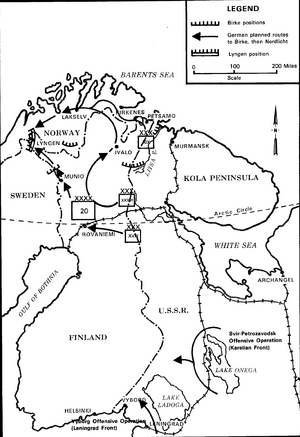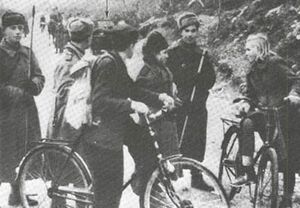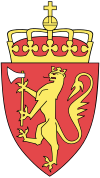الاحتلال الألماني للنرويج
The occupation of Norway by Nazi Germany during the Second World War began on 9 April 1940 after Operation Weserübung. Conventional armed resistance to the German invasion ended on 10 June 1940, and Nazi Germany controlled Norway until the capitulation of German forces in Europe on 8/9 May 1945. Throughout this period, Norway was continuously occupied by the Wehrmacht. Civil rule was effectively assumed by the Reichskommissariat Norwegen (Reich Commissariat of Norway), which acted in collaboration with a pro-German puppet government, the Quisling regime, while the Norwegian king Haakon VII and the prewar government escaped to London, where they formed a government in exile. This period of military occupation is, in Norway, referred to as the "war years", "occupation period" or simply "the war".
خلفية
Having maintained its neutrality during the First World War (1914–1918), Norwegian foreign and military policy since 1933 was largely influenced by three factors:
- Fiscal austerity promoted by fiscally conservative parties;
- Pacifism promoted by the Norwegian Labour Party;
- A doctrine of neutrality, on the assumption that there would be no need to bring Norway into a war if it remained neutral.
These three factors met resistance as tensions grew in Europe in the 1930s, initially from Norwegian military staff and right-wing political groups, but increasingly also from individuals within the mainstream political establishment and, it has since come to light, by the monarch, King Haakon VII, behind the scenes. By the late 1930s, the Norwegian parliament (Storting) had accepted the need for a strengthened military and expanded the budget accordingly, even by assuming national debt. As it turned out, most of the plans enabled by the budgetary expansion were not completed in time.
الاحتلال
القوى السياسية والعسكرية الألمانية
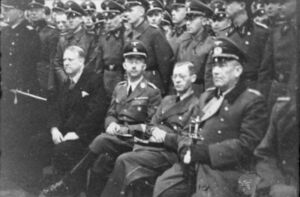
التحرير
حرب لاپلاند، والتقدم السوڤيتي وانسحاب الجيش الألماني
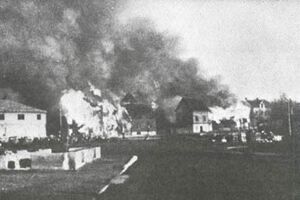
انظر أيضاً
المراجع
الهامش
ببليوگرافيا
- Boyne, Walter J. The Aircraft Treasures of Silver Hill: The Behind-The-Scenes Workshop of Our Nation's Air Museums. New York: Rawson Associates, 1982. ISBN 978-0-89256-216-9.
- Klemann, Hein A. M. & Kudryashov, Sergei (2011). Occupied Economies: An Economic History of Nazi-Occupied Europe, 1939–1945. London: Berg. p. 403. ISBN 978-1-84520-482-2.
للاستزادة
- Andenaes, Johs; et al. (1966). Norway and the Second World War. Oslo: Grundt Tanum.
- Dahl, Hans Fredrik (1999). Quisling: A Study in Treachery. New York: Cambridge University Press. ISBN 0-521-49697-7.
- Friis, Erik J. (1965). "The Norwegian Government-In-Exile, 1940–45". Scandinavian Studies. Essays Presented to Dr. Henry Goddard Leach on the Occasion of his Eighty-fifth Birthday. Seattle: University of Washington Press. pp. 422–444.
- Herrington, Ian (2004). The Special Operations Executive in Norway 1940–1945: Policy and Operations in the Strategid and Political Context (PhD thesis). De Montfort University, Leicester. hdl:2086/2421.
- Kersaudy, Francois (1998). Norway 1940. Lincoln: University of Nebraska Press. ISBN 0-8032-7787-3.
- Mann, Chris (2012). British Policy and Strategy Towards Norway, 1941–45. Basingstoke: Palgrave Macmillan. ISBN 978-0-230-21022-6.
- Riste, Olav & Nøkleby, Berit (1970). Norway 1940–45: The Resistance Movement. Oslo: Grundt Tanum.
- Vigness, Paul Gerhardt (1970). The German Occupation of Norway. New York: Vantage Press.
- Ziemke, Earl F. (2000) [1960]. "The German Decision to Invade Norway and Denmark". In Roberts Greenfield, Kent (ed.). Command Decisions. United States Army Center of Military History. CMH Pub 70-7.
وصلات خارجية
